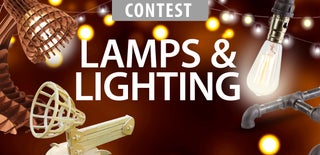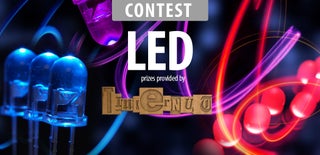Introduction: Concrete & Upcycled Glass Lamps
To form the concrete I used a wire wheel on some pine to expose the profile in the grain. The aluminum pieces are held together by brazing, it's a sort of aluminum welding, with a installation process more similar to soldering. The plexiglass is held on with silicone caulking. 2-part masonry epoxy is used to hold the frame to the concrete (except for the top which is attached with silicone in case of maintenance). The concrete was finished with a single coat of 2-part epoxy resin. The lighting used is a RGB LED flood light. Both of these are able to be operated off the same remote. Check out the details:
Step 1: Salvaging Materials
This build started like a lot of my builds ... in the dumpster.
There is another studio next door to me that is a glass blowing shop. Sometimes they will throw away their scrap colored glass, so that's how I was able to find this stuff in the dumpster.
Step 2: Cutting Aluminum Frame
The main frame is made from aluminum angle and bar stock scraps. I use the junk blade on my table saw to cut these down to size.
And I cut them to length on with my miter gauge.
To smooth out the ends, I clamped all the angles together and hit them with the belt sander.
Step 3: Brazing/Flattening Aluminum Frame
I attached the aluminum pieces together using brazing. The cinder block was a perfect working surface with the heat.
I heat up the aluminum pieces until they are hot enough to melt the brazing rod. You fill in the fillet until it's flush with the surface.
I use a sanding wheel in the angle grinder to sand all the joints flush.
Step 4: Forming for Concrete
The base of the lamps are made from cast concrete. I used these pine planks as the casting surface as I wanted to transfer the wood grain pattern to the concrete. To bring out the wood grain, I use a wire wheel in the angle grinder, which grinds off all of the soft material.
I screw the 4 sides together and hot glue them onto a sheet of melamine.
In the top and the bottom castings I used these aluminum pieces to create a dado for the aluminum frame to fit into.
In the base casting, I made a cavity from rigid foam for the lighting to fit into. I also made it a little oversized to take some weight off the lamps.
Step 5: Pouring & Patching Concrete
I just used a regular concrete mix for this. Mixed it and poured into the forms.
I vibrate the form to get a much air out of it as I can.
Once it's cured for a couple of days, I unscrew it and pull it out of the form. I ended up with quite a few bubbles in the first pour. With the 2nd one, I pushed the foam in after and came out with a better casting.
To fill in the bubbles in the first casting I filter out the aggregate from the concrete so I can use the sand/cement mixture to patch it.
I scrape the filler into the air bubbles and wait for this to cure.
Step 6: Grinding Concrete
Once all that is cured, it's time to shape everything. I use a diamond grinding wheel in my angle grinder to refine the shape of the dados.
I also grind off the corners to give them a little more shape.
Step 7: Finishing & Attaching Frame
As a finish I just used a 2-part epoxy resin. I mixed a little bit of this up to use as a thin coat because it gives it a bit of a shine and seals up the concrete.
I also used the epoxy to install some rubber feet onto the bottom of the lamps. I put the concrete lids on top while the epoxy dried to keep these in place.
Once that finish dries, I mixed up some 2-part concrete epoxy to attach the aluminum frames to the concrete base.
I push the frames onto the bases and wait for this adhesive to dry.
Step 8: Installing Light
Andddd after another wait for stuff to dry, it's finally time to wire up the light. I drill a hole out for the toggle switch and for the cord on the opposite side.
I used an LED flood light for this. Dissected it by pulling the screws off the back and separating the wires from the light.
I fish the wire in though the hole and screw it on.
The power wire goes through the switch, the neutral stays wired up to the circuit board, and the ground stays wired up to the main casing of the lamp.
Everything wired up and installed. It's a tight squeeze, but it fits...
... and it works!
(this is the light I used: http://amzn.to/2cE9gaN)
(this is the switch I used: http://amzn.to/2dkYWae)
Step 9: Installing Plexiglass
I cut down some plexiglass to use to hold the glass scraps in the lamp.
I made these boxes to put in the center of the lamps. It holds back the glass to cut down on weight and also allows the light to go from the base to the top of the light.
To attach the plexiglass around the sides of the lamps, I put silicone caulking around the perimeter of each piece.
Each side is installed against the silicone caulking. This would be enough to hold it in place once it dries...
But I decided to put some screws around the base too to make them a little more secure and also for looks.
Step 10: Putting the Glass In
I put the plexiglass boxes in the center and finally get to put the glass in the lamps.
Starting to look sharp!
I decided to install the concrete lid to the top of the lamp with silicone caulking. This holds it in place and also allows me to remove it in case the light or anything inside ever needs maintenance.
Step 11: Glamour Shots!
The same remote operates both of the LED flood lights. They are RGB LEDs so they can be changed to a whole bunch of colors.
I'll drop the link down here too, there's a build video for this!

Second Prize in the
Lamps and Lighting Contest 2016

Participated in the
LED Contest













